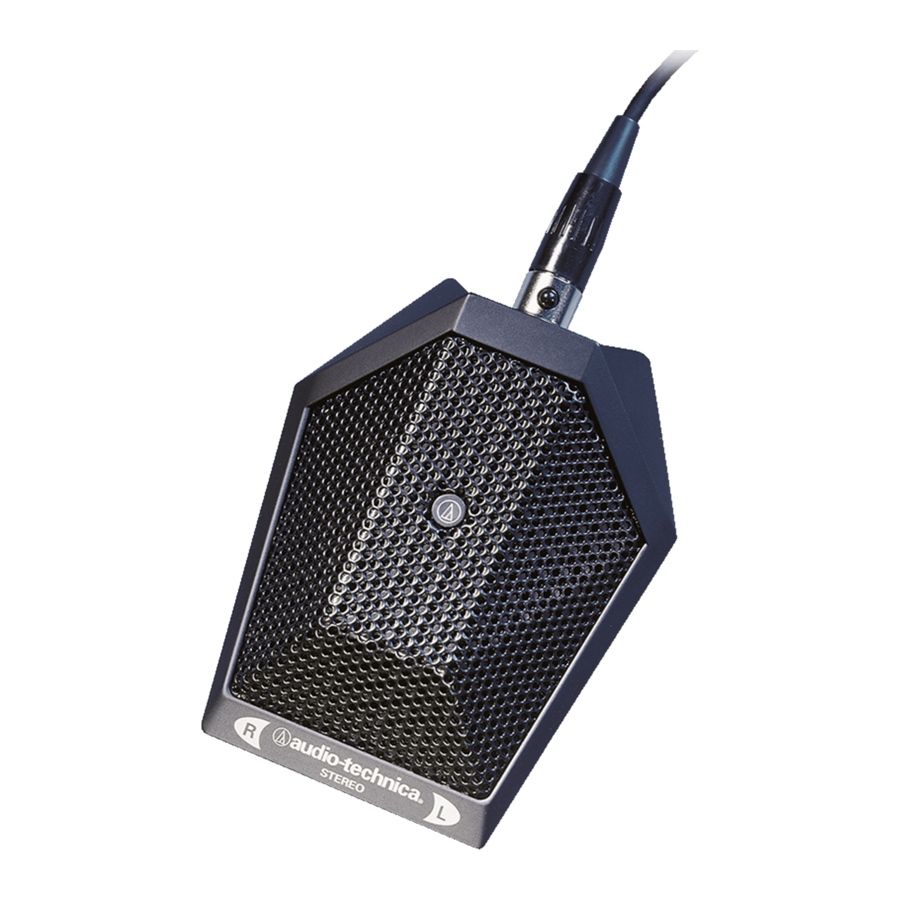Advertisement
Quick Links
AT849
STEREO BOUNDARY MICROPHONE
• Designed for surface-mount applications in broadcast,
professional recording and sound reinforcement
• Low-profile design for minimum visibility
• Pair of closely-matched cardioid elements provides the spatial
impact and realism of a live sound field
• The combination of a rugged die-cast case and rubber non-slip
bottom pad minimizes mechanical coupling of surface vibrations
to the microphone
• Switchable low-frequency roll-off
The AT849 requires 9V to 52V DC phantom power on each channel
for operation.
Output for each stereo channel is low impedance (Lo-Z) balanced.
The balanced signals of the TB5M output connector appear across
Pins 2 and 3 for the left channel, Pins 4 and 5 for the right channel.
Pin 1 is ground (shield) for both channels. Output is "Pins 2 and 4
hot" – positive acoustic pressure produces positive voltage at Pins 2
and 4.
The 3-pin XLRM cable connectors for the left and right channels are
marked with gray and red bands, respectively. The signal appears
across Pins 2 and 3; Pin 1 is ground (shield). Output phase is "Pin 2
hot" – positive acoustic pressure produces positive voltage at Pin 2.
The symmetr y and area of the mounting
surface directly affect the sensitivity of the
AT849 at low frequencies, as well as the overall
stereo balance and image. The microphone
60°
IDEAL
should be centered on the surface and
WORKING
ANGLE
positioned with the microphone facing the
sound source. The sound source should not
be below, or higher than 60° above, the plane of the mounting surface.
Locating the AT849 nearer the sound source enhances the width of
the stereo image, while decreasing room ambience. Conversely, as
the mic position moves away from the sound source, a narrower
left/right stereo image results and more of the "room sound" is noted.
The high sensitivity of the AT849 assures useful output and an
excellent match to most inputs. However, the microphone's high
output may overload some sensitive electronic input stages under
some conditions. Many pre-amps and mixers include a mic pad
or input attenuator control to prevent overload; or, use an AT8202
attenuator or equal at the input.
Avoid leaving the microphone in the open sun or in areas where
temperatures exceed 110° F (43° C) for extended periods. Extremely
high humidity should also be avoided.
AT849 SPECIFICATIONS
†
ELEMENTS
POLAR PATTERN
FREQUENCY RESPONSE
LOW FREQUENCY ROLL-OFF
OPEN CIRCUIT SENSITIVITY
CHANNEL BALANCE
IMPEDANCE
MAXIMUM INPUT SOUND LEVEL
SIGNAL-TO-NOISE RATIO
1
DYNAMIC RANGE (typical)
PHANTOM POWER
REQUIREMENTS
SWITCH
WEIGHT (less cable and accessory) 5.3 oz (149 grams)
DIMENSIONS
OUTPUT CONNECTOR
CABLE
ACCESSORY FURNISHED
† In the interest of standards development, A.T .U.S. offers full details on its test
methods to other industry professionals on request.
*1 Pascal = 10 dynes /cm
2
= 10 microbars = 94 dB SPL
1
Typical, A-weighted, using Audio Precision System One.
Specifications are subject to change without notice.
Stereo
Polar Pattern
0°
30°
330°
300°
60°
270°
90°
240°
120°
50
100
210°
150°
LEGEND
180°
SCALE IS 5 DECIBELS PER DIVISION
LEGEND
LEFT
RIGHT
1 kHz
1 kHz
Audio-Technica U.S., Inc., 1221 Commerce Drive, Stow, Ohio 44224
Audio-Technica Limited, Old Lane, Leeds LS11 8AG England
www.audio-technica.com
P51660-EN
©2004 Audio-Technica U.S., Inc.
Fixed-charge back plate
permanently polarized
condenser
X/Y stereo
30-20,000 Hz
150 Hz, 6 dB/octave
–40 dB (10.0 mV) re 1V at 1 Pa*
≤ 2.5 dB
200 ohms balanced
137 dB SPL, 1 kHz at 1% T.H.D.
67 dB, 1 kHz at 1 Pa*
110 dB, 1 kHz at Max SPL
9-52V DC, 2 mA typical
(each channel)
Flat, roll-off
3.62" (92.0 mm) maximum
length,
2.87" (73.0 mm) maximum width
Integral 5-pin TB5M
25' (7.6 m) long, shielded,
vinyl-jacketed, stereo cable with
5-pin TA5F connector at
microphone end, two 3-pin
XLRM-type connectors at
output end
Soft protective pouch
Frequency Response
200
500
1k
2k
10k
5k
Frequency in Hertz
12" or more on axis (flat)
Roll-off
Printed in Japan
10 dB
20k
Advertisement

















Need help?
Do you have a question about the STEREO BOUNDARY MICROPHONE AT849 and is the answer not in the manual?
Questions and answers